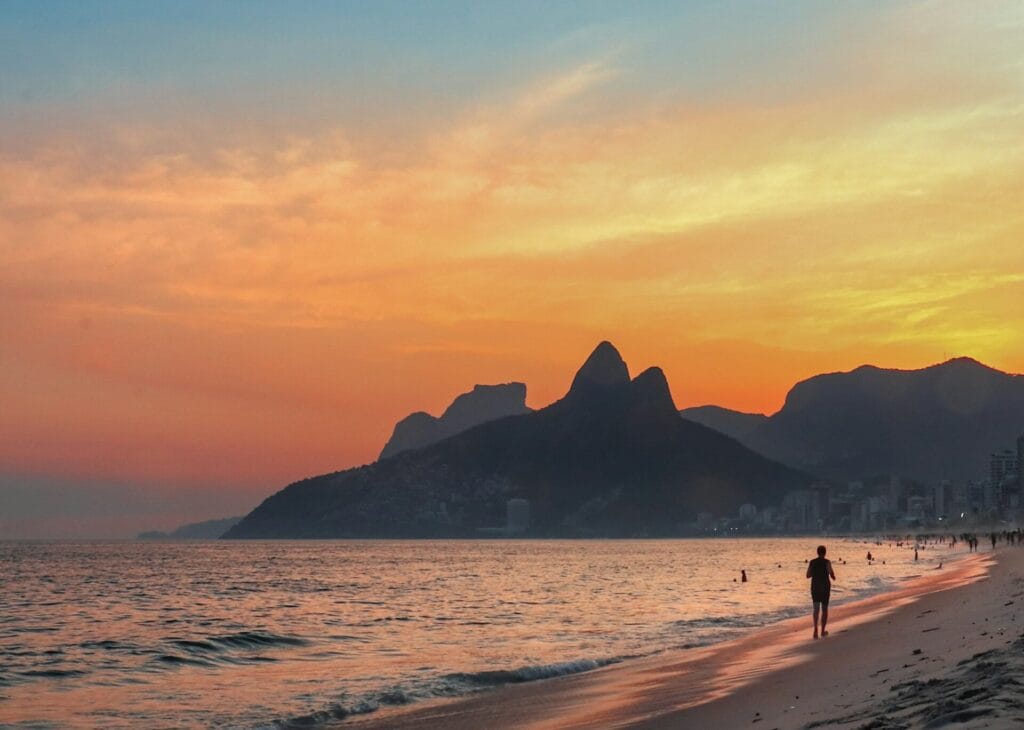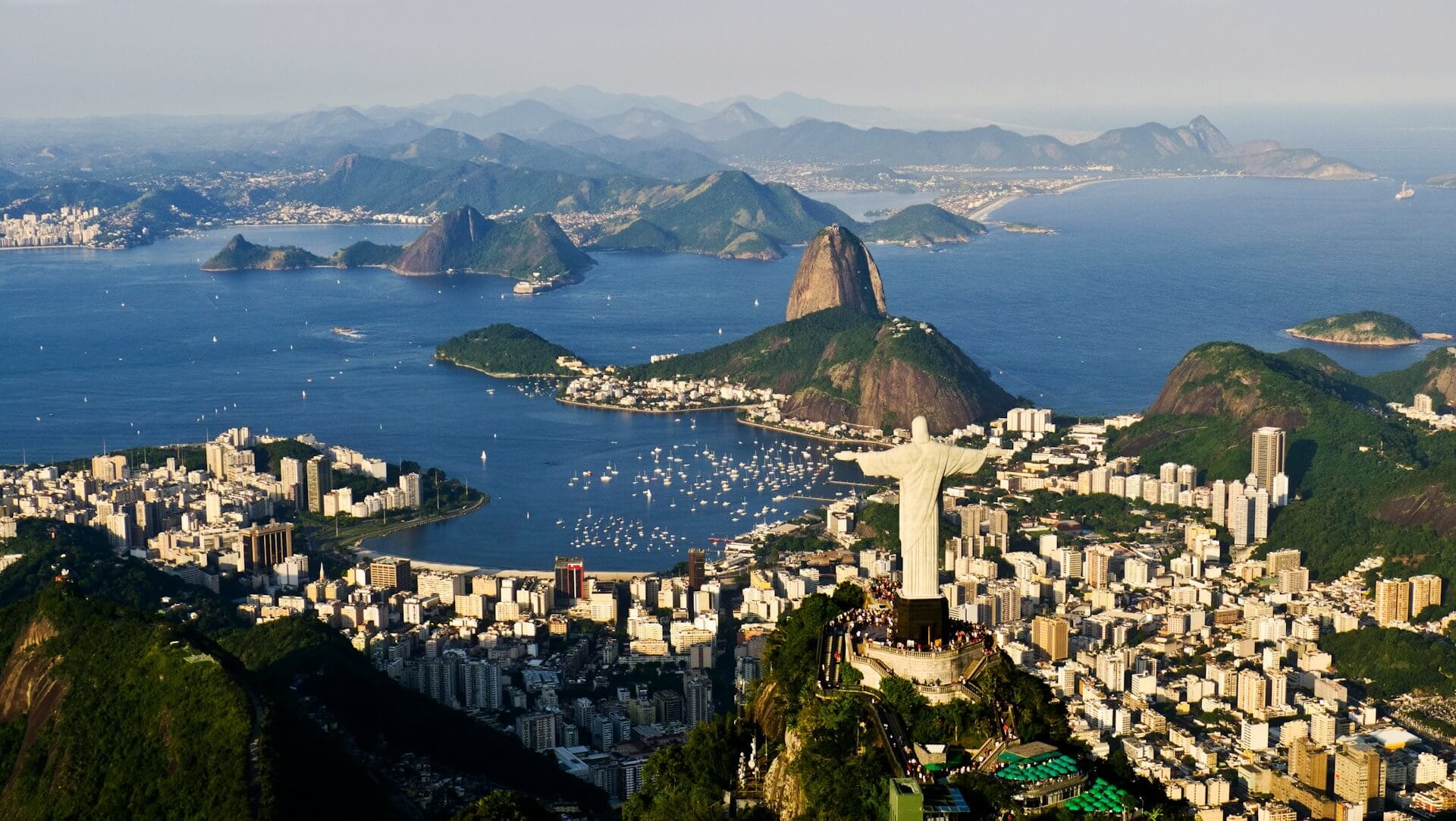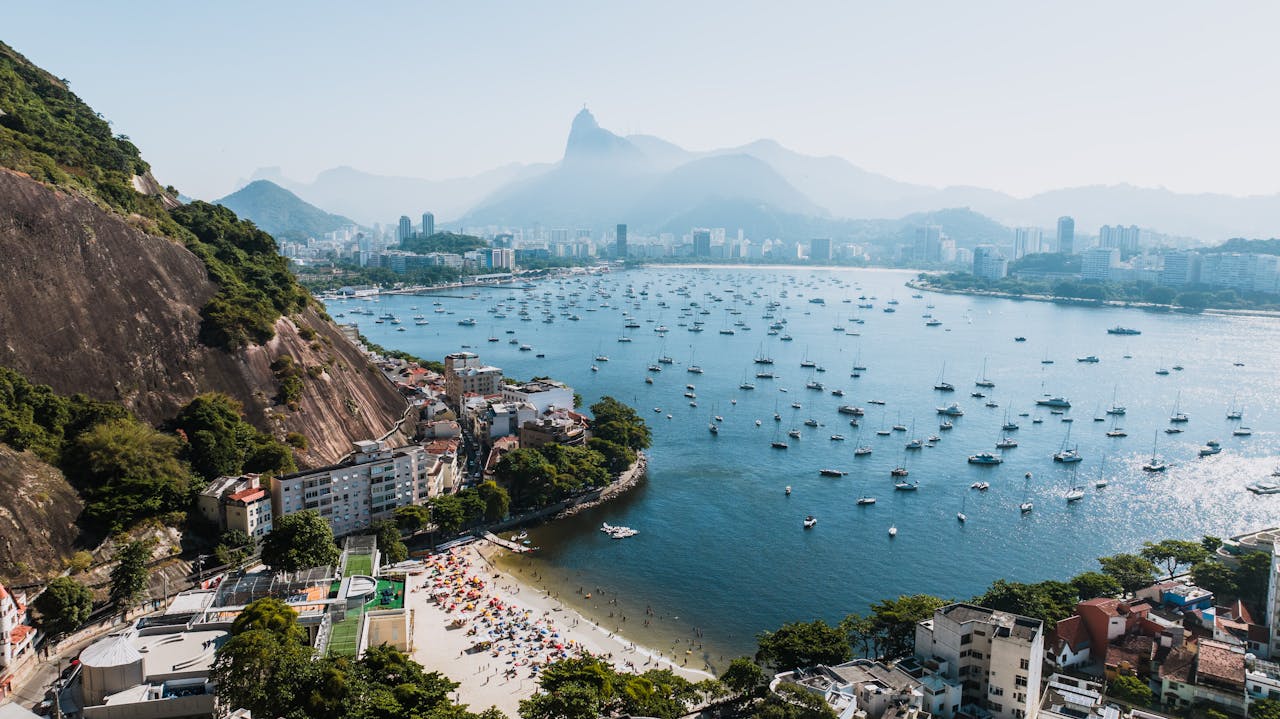
Are you planning a trip to Rio de Janeiro but unsure when to go?
This is a question many tourists ask themselves when they dream of visiting the Marvelous City.
Ultimately, choosing the best time to visit Rio de Janeiro will depend on your preferences, as each season and month offers its own unique variables.
Drawing from my research and personal experience, I’d like to share some valuable insights about the best time to travel to Rio de Janeiro.
My tip:
- Plan to stay for several days (at least five) to make the most of your trip.
- Check the weather forecast and organize your activities accordingly:
- Reserve sunny and clear days for attractions like Christ the Redeemer, Sugarloaf Mountain, and Morro Dois Irmãos.
- Enjoy the beaches on days without rain.
- Use rainy days to explore indoor attractions like museums, the historic city center, Olympic Boulevard, or treat yourself to a visit at Confeitaria Colombo.
Planning this way will help you enjoy everything Rio has to offer, no matter the weather!

Go to Rio during the summer months, from December to February, if you want to experience the city at its liveliest. This is when you can enjoy the famous New Year’s Eve celebrations, Carnival (which happens in February or sometimes March), and a calendar packed with parties, events, and vibrant energy.
Summer is widely regarded by many tourists as the best time to visit Rio de Janeiro.
However, be prepared for the heat. Temperatures are consistently high, often reaching up to 40°C (104°F) with an even higher heat index. While this is perfect for enjoying the beaches and water sports, the intense heat can be uncomfortable for other outdoor activities like hiking or visiting parks.
Afternoon rain showers are common but usually quick, so they won’t ruin your plans. However, they don’t do much to cool the heat.
Keep in mind that this is Rio’s high season, so prices for accommodations, flights, and activities will be higher than at other times of the year. The city will also be crowded with tourists, which adds to the vibrant atmosphere but may require extra planning to avoid long waits at popular attractions.
If you love excitement and energy, summer in Rio is perfect for you!
💡 If you want to travel during high season – like summer or Carnival – it’s best to plan ahead! Book your accommodation early – especially if you’re looking for budget-friendly options.
Best Time to Go to Rio de Janeiro: Autumn
From March to June, autumn in Rio is a time when the weather becomes milder and more pleasant. The intense summer heat gives way to sunny days, blue skies, and little rain, except for March, which can still be rainy. Temperatures range from 18°C to 25°C (64°F to 77°F), making it perfect for outdoor activities without being too hot.
This season brings fewer tourists, so attractions and hotels are less crowded. With lower demand, you can often find cheaper accommodation, making it the best time to go to Rio de Janeiro if you want a quieter and more affordable trip.
Autumn is also a beautiful season to enjoy Rio’s natural scenery. Famous beaches like Copacabana and Ipanema are less busy but just as stunning, especially with the gorgeous sunsets. Parks and green spaces like the Botanical Garden and Tijuca Forest are vibrant, with lush trees and blooming flowers adding to the charm.
The city looks amazing in autumn, with colorful nature blending beautifully with its historic architecture. It’s a peaceful and picturesque time to explore Rio de Janeiro!
Sign up Now for the Best Travel Tips exploring Brazil!
Get expert travel tips, detailed itineraries, and insider recommendations for your trip.
Best Time to Travel to Rio de Janeiro: Winter
Winter in Rio de Janeiro, from June to August, brings cooler temperatures and little rain, making it the driest season of the year. The weather is still pleasant during the day, with an average temperature of around 21°C (70°F), so the winter here is far from harsh.
These months are actually very enjoyable, as it’s neither too hot nor too cold. The season is characterized by sunny days and cool evenings, offering an ideal climate for beach visits or any outdoor activity without the risk of sunburn.
Another advantage of winter is the reduced rainfall compared to summer, which makes it great for outdoor activities like hiking, walking, and exploring parks. While the ocean water is slightly cooler, the beaches are still lively, especially on sunny weekends. Even if you don’t feel like swimming, strolling along the shoreline can be just as enjoyable.
Winter is the best time to travel to Rio de Janeiro for tourists who prefer milder temperatures and dry weather. It offers perfect conditions for exploring the city, enjoying hiking trails, walking tours, parks, and even visiting museums.
Additionally, this season offers lower prices and fewer crowds at beaches and tourist attractions compared to summer. For those seeking a quieter, more relaxed trip, winter in Rio is the perfect time to visit.

Best Season to Visit Rio de Janeiro: Spring
Spring in Rio de Janeiro, from September to November, is a season of transition, when the city bursts with vibrant colors and offers a taste of the summer ahead.
The weather is warmer, with temperatures ranging between 21°C and 28°C (70°F to 82°F). The city comes alive with blooming flowers, blue skies, and stunning sunsets in beautiful hues, making it an ideal time for outdoor activities.
This season is perfect for exploring Rio’s parks and gardens, like the Botanical Garden, which is especially beautiful with flowers in full bloom. It’s also a great time for picnics, brunches, enjoying outdoor bars, watching the sunset, hiking, and, of course, relaxing on the beach.
Spring is the best time to visit Rio de Janeiro for tourists who want slightly warmer weather than autumn and winter but not as hot as summer. Additionally, spring offers a more affordable option compared to the high prices of summer, making it a great choice for those seeking a balance between pleasant temperatures, natural beauty, and budget-friendly travel.
When to Visit Rio de Janeiro: Month by Month
Rio de Janeiro in January
Weather: January is peak summer in Rio, with temperatures often soaring to 30-35°C (86-95°F), but the heat index can feel much higher. The weather is hot, humid, and rainy, with frequent afternoon thunderstorms that cool things down temporarily but do little to ease the heat.
Tourism: This is Rio’s high season, with many tourists flocking to the city after New Year’s celebrations. Popular spots like Copacabana and Ipanema beaches are bustling with activity, not only from tourists but also from locals making the most of the summer and school holidays. Beaches are a favorite escape for everyone during this time.
Costs: Prices are at their peak in January. Hotels, restaurants, and tours charge high-season rates, making it an expensive time to visit. If you’re on a budget, this is not the best time to visit Rio de Janeiro for you.
Activities and Events: Summer in Rio is perfect for outdoor fun, especially beach activities, which are at their best this time of year. The city is alive with parties, celebrations, and a buzzing atmosphere. January is also a pre-Carnival month, with street parties, known as blocos, beginning to pop up, giving visitors a taste of the Carnival excitement to come.
I highly recommend booking your tickets to Christ the Redeemer and Sugarloaf ahead of time if you’re visiting in January – it’s high season, and spots fill up fast! GetYourGuide offers great options for both landmarks.
Rio de Janeiro in February

Weather: February remains hot and humid, with average temperatures similar to January and sometimes even hotter. There are fewer rain showers compared to January, but the heat and humidity are still intense.
Tourism: February is the best time to visit Rio de Janeiro if you want to experience Carnival. Tourists from around the world flood into Rio to experience the world-famous celebration. The city is at its busiest, with packed streets, beaches, and attractions.
Costs: Carnival week is one of the most expensive times of the year in Rio, second only to New Year’s Eve. Prices for accommodations and flights skyrocket, and everything from food to tours becomes more expensive. Booking well in advance is essential to secure your spot and avoid higher last-minute rates.
Activities and Events: Carnival is the highlight of February and the most vibrant event of the year. Samba parades, lively street parties (blocos), and colorful costumes take over the city. Even if you’re not participating in the official parade, the excitement is everywhere, with music, dancing, and celebrations spilling into every corner of Rio.
🎭 Planning to experience the Rio Carnival? Make sure to get your tickets in advance – they sell out fast! There are options with or without food, drinks, and even transfers, so you can choose the experience that fits your style. Check available Carnival tickets on GetYourGuide.
If you want to enjoy Carnival festivities without the high accommodation costs, consider visiting during the three weeks before Carnival for the pre-Carnival celebrations. These blocos and street parties grow more exciting every year and offer an authentic taste of the season.
Outside of Carnival, February is still a great time to enjoy Rio’s beaches and explore its famous landmarks like Christ the Redeemer and Sugarloaf Mountain. Just be prepared for the summer heat and crowds!
Rio de Janeiro in March
Weather: March brings slightly cooler temperatures compared to the peak summer months, but it’s still warm and pleasant, averaging around 29°C (82°F). Rain showers are more frequent, especially in the afternoons, but they’re usually brief and don’t disrupt plans for long.
Tourism: After Carnival, the number of tourists drops significantly, making March a quieter and more relaxed time to visit. Beaches are less crowded, and you’ll find shorter lines at the city’s major attractions like Christ the Redeemer and Sugarloaf Mountain.
Costs: March marks the start of the shoulder season, so prices for accommodations, flights, and activities begin to drop. It’s a more budget-friendly time to experience Rio compared to the busy months of January and February.
Activities and Events: March is ideal for sightseeing, whether you’re exploring museums, hiking or simply enjoying the beaches with fewer people. While most of the Carnival excitement has died down, you may still find some lingering post-Carnival street parties, though they’re much more low-key.
Rio de Janeiro in April
Weather: April marks the beginning of autumn in Rio, with warm but more moderate temperatures. Highs range from 26-28°C (79-82°F), and rainfall decreases significantly compared to the earlier months. The weather is pleasant, making it ideal for outdoor activities.
Tourism: April is one of the quieter months for tourism in Rio, offering a more relaxed experience with fewer crowds. However, during Semana Santa (Holy Week), an important holiday in Brazil, the city sees an influx of visitors, and attractions may get busier.
Costs: Prices are generally lower in April, making it a great option for budget-conscious travelers and can be considered the best month to visit Rio de Janeiro for this type of traveler. Be aware that costs might rise slightly during Semana Santa, so booking in advance for this period is a good idea.
Activities and Events: April is perfect for outdoor adventures like hiking and exploring Rio’s beautiful parks. It’s also a great time for sightseeing at famous landmarks. The beaches remain enjoyable, though the water may be a bit cooler.

Rio de Janeiro in May
Weather: May is the heart of Rio’s autumn season. Temperatures range from 24-26°C (75-79°F), and lower humidity levels make the weather comfortable for outdoor activities. Rainfall is minimal, so you’ll enjoy sunny, pleasant days perfect for exploring the city.
Tourism: May can be the best time to go to Rio de Janeiro, as it is one of the least touristy months. The city feels more laid-back, with fewer visitors at popular attractions, making it ideal for those seeking peace and a quieter experience.
Costs: May offers fantastic value for travelers, with some of the lowest prices for flights and accommodations. However, around Dia das Mães (Mother’s Day, the second Sunday in May), prices may increase slightly due to the holiday. Booking early for this weekend is recommended.
Activities and Events: May’s mild weather is perfect for hiking and outdoor exploration. You can comfortably visit parks like the Tijuca Forest or enjoy trails like Pedra Bonita. It’s also an ideal time for cultural experiences, such as visiting museums, theaters, and cultural centers. Food lovers will appreciate the deals many restaurants offer during this time, featuring fresh autumn ingredients.
Rio de Janeiro in June
Weather: June brings cooler, comfortable weather, with daily temperatures around 25°C (77°F) and cooler evenings, and can be the best time to visit Rio de Janeiro for those who prefer milder temperatures. Rain is rare, typically occurring briefly with the passage of cold fronts, which are less frequent and quicker than in summer.
Tourism: June is not a peak tourist month, so the city feels quieter, making it a great time to explore without crowds.
Costs: Prices remain low in June, making it a budget-friendly time to visit. However, around Dia dos Namorados (Brazilian Valentine’s Day on June 12), prices for accommodations and dining may rise slightly, as it’s an important holiday. Booking early for this date is a good idea.
Activities and Events: June is perfect for exploring Rio’s historic neighborhoods, such as Santa Teresa, or hiking in the city’s scenic areas. The season also features Festa Junina, a traditional Brazilian festival celebrated with lively street parties, traditional foods like pamonha and canjica, and music like forró. These festivities offer a wonderful opportunity to experience authentic Brazilian culture.
Rio de Janeiro in July
Weather: July is winter in Rio, with daytime temperatures averaging 25°C (77°F) and cooler nights. The weather is dry and mild, ideal for those who prefer cooler conditions. However, if a cold front passes through, expect two or three days of rain and colder temperatures.
Tourism: July is busier than other winter months due to Brazilian school holidays. Domestic tourists, particularly families, often visit Rio during this time, so attractions may be more crowded than usual.
Costs: Hotel and flight prices increase during the school break but remain more affordable than during the summer peak season. Planning ahead can help secure better deals.
Activities and Events: The mild weather is perfect for sightseeing without the discomfort of intense heat. You can comfortably explore iconic attractions like Christ the Redeemer, Sugarloaf Mountain, and the city’s museums. Cooler temperatures also make it an excellent time for hiking trails such as Corcovado or Pedra Bonita.
While the beaches are less crowded, they’re still lovely for walking or sunbathing. However, the ocean water might feel too cold for swimming.
Rio de Janeiro in August

Weather: August brings mild days and cool evenings, with temperatures around 26°C (79°F). It’s a generally dry month, but occasional cold fronts can bring two or three days of rain and cooler weather. Windy conditions are also common during this time, adding a refreshing feel to the air.
Tourism: August is one of the quietest months for tourism in Rio. Attractions are less crowded, and the city has a more laid-back atmosphere, perfect for travelers looking to avoid the peak season hustle.
Costs: With fewer tourists, August offers excellent deals on accommodations, tours, and flights. It’s a great option for budget-conscious travelers seeking a mix of affordability and good weather.
Activities and Events: The mild weather in August is perfect for cultural and outdoor activities. It’s an ideal time to explore art galleries, historical sites, and cultural centers at your own pace. Hiking and nature reserves are enjoyable with the pleasant temperatures, and sunny days are great for beach outings. On clear days, you can relax at beaches without the intense heat of summer.
My Experience: I chose to visit Rio in August because it’s the low season, with fewer tourists, lower prices, and cooler weather—ideal for the mix of activities I wanted, such as visiting famous outdoor attractions, exploring parks, hiking, and walking through the historic center. Thus, according to my preferences, August was the best time to visit Rio de Janeiro.
My experience was mostly positive. For the first few days, I enjoyed sunny weather, perfect for all the outdoor plans I had made. However, on the fourth day, the weather changed, and it started raining in the late afternoon. The rain persisted through the day, bringing cooler temperatures and a slight chill. Rainy days in Rio limit outdoor options, so I shifted to indoor activities like exploring museums and other covered spaces.
By the next day, the rain stopped, and though it remained cloudy, I was able to visit the historic center and the Olympic Boulevard. The sun returned for the remaining days of my trip, accompanied by some wind, but it was still possible to enjoy the city and the beach.
Planning your activities based on the weather is essential. Knowing that a cold front might pass, I organized my itinerary accordingly, and it worked out well. I recommend this approach to anyone visiting Rio. Have a flexible plan and adapt to the weather to make the most of your trip!
Rio de Janeiro in September
Weather: September marks the beginning of spring in Rio, with temperatures starting to rise and the heat becoming more noticeable. Daytime temperatures typically average around 27°C (81°F), with highs occasionally reaching slightly above that. Rain showers are possible but infrequent.
Tourism: Tourism is relatively low in early September, providing a calm and relaxed atmosphere. However, it picks up toward the end of the month as the weather becomes warmer. The city can get very crowded during two significant events:
- Rock in Rio: One of the world’s largest music festivals, held in September every two years, draws massive crowds.
- Independence Day (September 7): This national holiday brings many domestic tourists.
Costs: Prices in early September are relatively affordable, although they start to rise as spring progresses and more tourists arrive. They rise significantly during Rock in Rio and the Independence Day holiday. Booking accommodations early is advisable if you’re visiting during these periods.
Activities and Events: Spring in Rio is great for outdoor adventures. You can enjoy hiking, relaxing at the beach, or exploring famous landmarks.
Rio de Janeiro in October
Weather: October brings warmer, sunny days, with temperatures averaging 28°C (82°F) or more. Rain showers become more frequent but are usually short.
Tourism: October is still part of the shoulder season, so while tourist numbers are higher than during the winter months, the crowds are not overwhelming. This makes it the best time to travel to Rio de Janeiro if you prefer a balance between liveliness and tranquility.
Costs: Prices remain moderate, and it’s possible to find good deals on accommodations and flights, especially if you book in advance. However, costs may rise around Dia de Nossa Senhora Aparecida (October 12), a significant holiday in Brazil.
Activities and Events: October is ideal for enjoying the beach and Rio’s outdoor attractions.
Rio de Janeiro in November
Weather: November marks the transition to summer, with temperatures rising to around 28-30°C (82-86°F). Rain showers become more frequent.
Tourism: Tourist numbers begin to rise as visitors arrive in preparation for the holiday season, but November is still quieter than the peak months of December and January.
Costs: Prices start to climb as Rio gears up for high season, so booking early is recommended to secure better deals. During Dia dos Finados on November 2 and the Proclamation of the Republic holiday on November 15, which are both national holidays, prices may spike, particularly for accommodations and flights.
Activities and Events: November is a great time to enjoy Rio’s beaches, explore hiking trails, and visit the city’s famous landmarks. Toward the end of the month, the pre-Carnival street parties begin, offering an early taste of Rio’s famous Carnival excitement.
Rio de Janeiro in December

Weather: December marks the start of summer in Rio, with hot and sunny days. Average temperatures hover around 30°C (86°F) or more, and while the chance of rain is moderate, it’s usually in the form of brief, heavy summer storms. Most days remain sunny, ideal for outdoor activities.
Tourism: December is the beginning of Rio’s high season, attracting tourists in large numbers, especially as the holidays and New Year celebrations approach. The city gets busier throughout the month, and beaches like Copacabana and Ipanema become increasingly crowded.
Costs: Prices are at their highest in December, particularly in the lead-up to New Year’s Eve. Hotels, flights, and tours charge premium rates, so it’s an expensive time to visit. Early bookings are essential to secure better prices and availability.
Activities and Events: December is perfect for outdoor fun and festive celebrations. The beaches are at their best, bustling with locals and tourists alike. New Year’s Eve at Copacabana Beach is the highlight of the month, featuring spectacular fireworks, live music, and millions of people celebrating together. For those who love parties and excitement, December is the best time to visit Rio de Janeiro.
Aside from the iconic Copacabana festivities, there are numerous parties around the city to suit all budgets, including the traditional New Year’s Eve events at the Copacabana Palace Hotel, Jockey Club, and others.
If you plan to attend a New Year’s Eve event, make arrangements early. Buy tickets in advance and plan your transportation, as the city can become very crowded, and moving around may take longer than usual.
Conclusion: Best time To Go to Rio de Janeiro
Ultimately, the best time to visit Rio de Janeiro depends on your preferences.
By considering the month-by-month differences in weather, crowds, and prices, you can find the perfect time to experience all that Rio de Janeiro has to offer.



